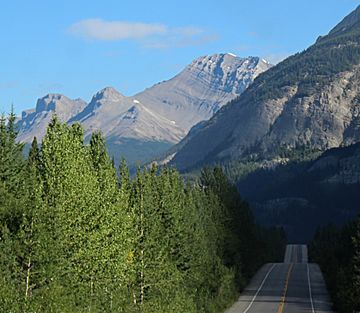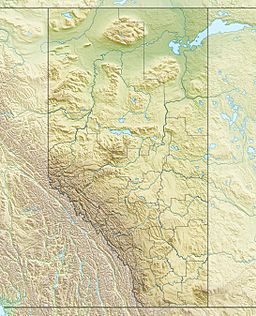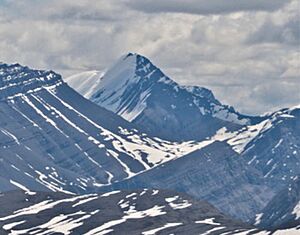Mount Coleman (Alberta) facts for kids
Quick facts for kids Mount Coleman |
|
|---|---|

Mount Coleman (centered in distance) seen from Icefields Parkway
|
|
| Highest point | |
| Elevation | 3,135 m (10,285 ft) |
| Prominence | 775 m (2,543 ft) |
| Parent peak | Cirrus Mountain (3270 m) |
| Listing | Mountains of Alberta |
| Geography | |
| Location | Alberta, Canada |
| Parent range | Canadian Rockies |
| Topo map | NTS 83C/02 |
| Type of rock | Sedimentary |
Mount Coleman is a tall mountain in Banff National Park, Alberta, Canada. It stands about 3,135 meters (10,285 feet) high. This mountain is part of the amazing Canadian Rockies mountain range.
Mount Coleman is located in the upper North Saskatchewan River valley. You can see it from the Icefields Parkway, a famous scenic road. It sits between Saskatchewan Crossing and Sunwapta Pass. The closest higher mountain is Cirrus Mountain, which is about 4.5 kilometers (2.8 miles) to the north.
Contents
History of Mount Coleman
Mount Coleman got its name in 1898. It was named after Arthur Philemon Coleman (1852-1939). He was a Canadian geologist, which is a scientist who studies rocks and the Earth.
Arthur P. Coleman was one of the first non-Indigenous explorers to visit the area. This area is now known as Jasper National Park.
How Mount Coleman Formed (Geology)
Like many other mountains in Banff National Park, Mount Coleman is made of sedimentary rock. This type of rock forms from layers of sand, mud, and tiny bits of sea creatures that settle at the bottom of ancient seas. Over millions of years, these layers get pressed together and turn into solid rock.
The rocks in Mount Coleman formed during periods from the Precambrian to the Jurassic times. Later, huge forces deep within the Earth pushed these rocks. This caused them to move east and even slide over younger rocks. This big event is called the Laramide orogeny. It helped create the towering mountains we see today.
Climate Around Mount Coleman
The climate around Mount Coleman is called a subarctic climate. This means it has very cold and snowy winters. The summers are usually mild, not too hot.
Temperatures can drop very low, sometimes below -20 °C (-4 °F). With the wind, it can feel even colder, below -30 °C (-22 °F). The snow and rain that fall on Mount Coleman flow into streams. These streams then join the North Saskatchewan River.
Images for kids





